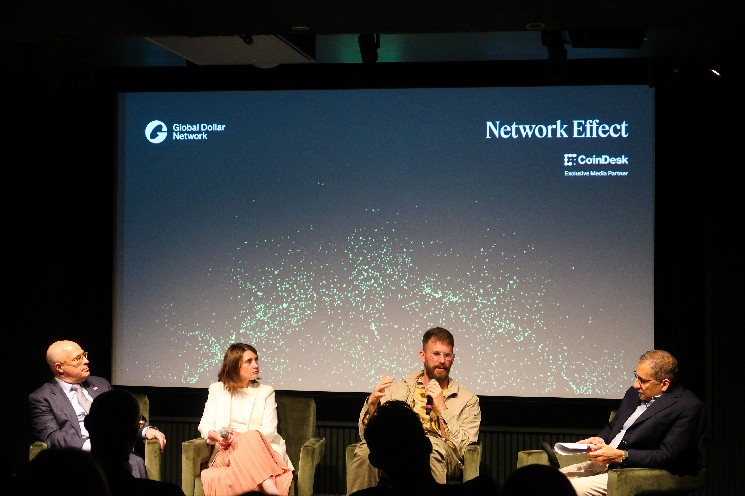The competition to define the future of money is getting faster. According to industry leaders, Stablecoins are at the heart.
“The most important item on the roadmap is to understand how fast we can move, and it is clear that the next three years will be the fastest we’ve ever seen in digital asset development,” said Sergio Mello, head of Stablecoins at Anchorage Digital during Paxos’ global dollar network event in New York City.
“2025 will be clear here, 2026 will be clear elsewhere, and 2027 will be all that happens.”
Melo was not speaking hypothesis. He sees Stablecoins as a fundamental upgrade to the global monetary system rather than as a niche financial product, from his favourite location within one of the first federally chartered crypto banks in the United States.
“Stable coins are a better expression of Fiat and a better way to move Fiat, but you’re really just money moving,” he said. “The transport layer and value layer are integrated into the same device.”
This evolution of money is far from theory.
According to Mello, industry players in payment networks, custodians and financial services providers lay the foundations for what he called the “critical mass” of institutional adoption. “That’s where the money is moving forward,” he said.
From experiments to infrastructure
It was once considered a tool for crypto speculators or offshore arbitrators. However, according to MasterCard EVP Raj Dhamodharan, that perception is changing rapidly.
Stablecoins have become increasingly functioning as a “money mobile tier” in more and more mainstream use cases, he said, adding that cross-border remittances, B2B payments and even retail spending are already tracting.
For example, MasterCard has a card that allows the user to choose which currency (Fiat or Stablecoin) but merchants can select what they want to receive. “We started it with a card. We started it with a transfer,” Dhamodharan said.
WorldPay’s Ahmed Zifzaf reflected this and explained how customers can use Stablecoins for real-time financial management. “We can see how we can accelerate all of these payments and financial flows,” he said. WorldPay said it is focused on expanding those efforts by working with “combat-tested” blockchains like Solana.
The Banker’s Dilemma
Still, not all financial institutions are in a hurry.
“What are the restrictions you have since you’re a bank?” asked Luca Cosentino of Cross River. The barriers are real, he said — the legacy technology stack, compliance risks and cultural resistance are all slowing down the pace of innovation. However, the division of strategies is apparent.
“Certain banks don’t touch Crypto (…) (…) others focus on custody (…) some others try to focus on money movements,” he said. “But there is little doubt that a large portion of the bank (…) will somehow end up in crypto.”
Sunil Sachdev of Fiserv focused on the same disparity. “We had about 12 banks ready,” he said, explaining that the new rules under SAB 121 effectively frozen many of these plans. “After that, everything closed in just one day.” But interest has not faded, especially among small banks.
“The bigger guys look cautious,” he said. “Small banks are trying to use this as an opportunity to bring in low-cost deposits, which is much more aggressive. They see this as an opportunity to distinguish themselves.”
He painted a vivid picture of how small town banks evolve: three branches, deep community ties, and the roadmap that will now become a “trusted node” in the global blockchain network, offering iconic financial products that are not available elsewhere.
Better than Fiat
Many people in the industry assume that institutions will lead adoption, but Mark Greenberg of Kraken is not so sure. “Americans may actually be part of the last group to adopt the world’s dollar,” he said. However, outside the US, demand is strong.
“We believe that global dollars are better than holding Fiat, and we’re going to see that,” he said.
And it’s not just used for savings. “You save money there. You use your card there. At some point, you transfer to a friend and pay the bill,” he said. “And maybe you’ll buy meme coins or stock.”
Six Man Ventures’ Mike Dudas suggested that the app layer promotes consumer behavior. Stablecoins are “the basics that people need to be able to preserve their value,” he said. “And now, you can actually spend the dollars I get for Visa, MasterCard and Off-Ramp providers.”
The Solana Foundation’s Sheraz Shere added that infrastructure has now come to exist to support these ambitions. “There’s this assumption that TradFi infrastructure is good,” Greenberg said. “There’s also a stop (Tradfi institution) there.” Instead of speaking performance, he said the best strategy is to let the outcome speak for himself. “The less we talk about it, the better it is.”
A drama to strengthen control of the US dollar
According to former CFTC chair Chris Giancarlo, stubcoin is often discussed through the lens of innovation and financial inclusion, but policymakers may be thinking something more immediate. It’s US debt demand.
“95% of the driving force behind the Stablecoin law is to create more demand for the US Treasury,” he said. “The remaining 5% simply formulate which regulators are monitoring.”
It’s not a cryptic story, Giancarlo argued. Stablecoins are now seen as a way to strengthen the global role of the US dollar by digitizing and distributing them at scale. “Stablecoins demonstrates that global demand for the dollar far outweighs supply in the analog world, demonstrating that the beauty of Stablecoins meets that demand,” he said.
Chain Olisis CEO Jonathan Levin said banks are carefully entering the space, focusing more on asset stability and market contagion than most crypto-born companies. “When it comes to banks, they see it and they say. I need to understand the stability of my assets, as well as the stability of all other assets.”
According to Levin, data becomes important. Issuers need to track performance across thousands of currency pairs and venues, but they need to manage their risks without compromising decentralization. “It’s a critical data challenge,” he said.
A few years to come
As legislative efforts progressed in Washington, many panelists agreed that durable rules regarding reserves, on-ramps and disclosures are lagging behind. However, future opportunities are greater than compliance.
“The bottom row is in America’s interest that the dollar continues to function as a global reserve currency, even if politicians focus on the demands of the Treasury,” Giancarlo said.
By the end of the day, one theme cut all four panels. Stablecoins are no longer an experiment. Whether small banks are looking for relevance, businesses are chasing faster settlements, or regulators are responding to Treasury pressures, the Stablecoin ecosystem is moving fast.
Read more: Citi predicts that Stablecoins will expand beyond crypto trading and become part of the mainstream economy










